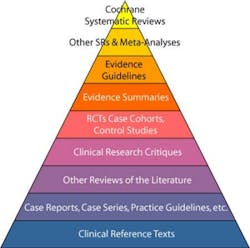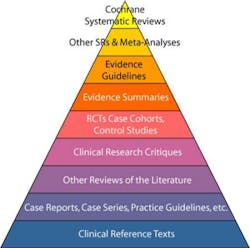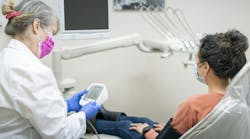Scientific evidence available on intrerdental cleaning
By Dagmar Else Slot, MSc
Americans like floss and the oral irrigator, while in Europe the woodstick and interdental brushes are often advised. In the November 2008 issue of the International Journal of Dental Hygiene, the research group ACTA--where several dental hygienists are involved--published four systematic reviews about interdental cleaning (dental floss, woodsticks, interdental brushes and oral irrigator). The highest level of evidence that is currently available with respect to various aspects of oral hygiene is presented in systematic reviews.
Americans like floss and the oral irrigator, while in Europe the woodstick and interdental brushes are often advised. In the November 2008 issue of the International Journal of Dental Hygiene, the research group ACTA--where several dental hygienists are involved--published four systematic reviews about interdental cleaning (dental floss, woodsticks, interdental brushes and oral irrigator). The highest level of evidence that is currently available with respect to various aspects of oral hygiene is presented in systematic reviews.
These methods include hypothesis formulation, literature searches, critical appraisal, trial planning, ethical review, trial conduct, trial reporting, systematic reviews and meta-analyses. Systematic reviews of randomized controlled trials are seen as the gold standard for assessing the effectiveness of healthcare interventions. Recently, a summary wass published in Periodontology 2000.(1)The fact that floss does not appear to be effective in the hands of the general public does not preclude its use. Although floss should not be the first tool recommended for cleaning open interdental spaces, if the patient does not like any other tool, flossing could still be part of oral hygiene instruction. However, dental professionals should realize that proper instruction, sufficient motivation of the patient and a high level of dexterity are necessary to make the flossing effort worthwhile.(2)None of the studies that scored visible interdental plaque demonstrated any significant advantage of using woodsticks as opposed to alternative methods (toothbrushing only, dental floss or interdental brushes) in patients with gingivitis. The use of triangular woodsticks resulted in a significant incremental improvement in gingival health.(3)All three studies that compared interdental brushes as an adjunct to brushing showed a significant difference in favor of the use of interdental brushes for plaque removal. The majority of the studies showed a positive significant difference on the plaque index when using interdental brushes compared with floss. No differences were found for the gingival or bleeding indices. Meta-analysis showed superiority of the interdental brush to floss with respect to plaque removal.(4)
With respect to plaque, no significant differences were observed with the adjunctive use of the oral irrigator. All three studies that presented data on bleeding scores showed significant reductions in the oral irrigator group compared to the regular oral hygiene group. When observing visual signs of gingival inflammation, the majority of the studies found a significant effect with use of an oral irrigator as an adjunct to regular oral hygiene.(5)With respect to interdental cleaning, the best available data suggests the use of interdental brushes. These brushes should therefore be the first choice in patients with open interdental spaces. In light of the results of the reviewed research and critical analysis, it is evident that mechanical oral hygiene plays an important part in the prevention and treatment of periodontal disease.(1)References
1. van der Weijden F, Slot DE. Oral hygiene in the prevention of periodontal diseases: the evidence. Periodontol 2000. 2011 Feb;55(1):104-23. doi: 10.1111/j.1600-0757.2009.00337.x. Review. PubMed PMID: 21134231.2. Berchier CE, Slot DE, Haps S, Van der Weijden GA. The efficacy of dental floss in addition to a toothbrush on plaque and parameters of gingival inflammation: a systematic review. Int J Dent Hyg. 2008 Nov;6(4):265-79. Review. PubMed PMID:19138178.3. Hoenderdos NL, Slot DE, Paraskevas S, Van der Weijden GA. The efficacy of woodsticks on plaque and gingival inflammation: a systematic review. Int J Dent Hyg. 2008 Nov;6(4):280-9. Review. PubMed PMID: 19138179.4. Slot DE, Dörfer CE, Van der Weijden GA. The efficacy of interdental brushes on plaque and parameters of periodontal inflammation: a systematic review. Int J Dent Hyg. 2008 Nov;6(4):253-64. Review. PubMed PMID: 19138177.5. Husseini A, Slot DE, Van der Weijden GA. The efficacy of oral irrigation in addition to a toothbrush on plaque and the clinical parameters of periodontal inflammation: a systematic review. Int J Dent Hyg. 2008 Nov;6(4):304-14. Review. PubMed PMID: 19138181.
1. van der Weijden F, Slot DE. Oral hygiene in the prevention of periodontal diseases: the evidence. Periodontol 2000. 2011 Feb;55(1):104-23. doi: 10.1111/j.1600-0757.2009.00337.x. Review. PubMed PMID: 21134231.2. Berchier CE, Slot DE, Haps S, Van der Weijden GA. The efficacy of dental floss in addition to a toothbrush on plaque and parameters of gingival inflammation: a systematic review. Int J Dent Hyg. 2008 Nov;6(4):265-79. Review. PubMed PMID:19138178.3. Hoenderdos NL, Slot DE, Paraskevas S, Van der Weijden GA. The efficacy of woodsticks on plaque and gingival inflammation: a systematic review. Int J Dent Hyg. 2008 Nov;6(4):280-9. Review. PubMed PMID: 19138179.4. Slot DE, Dörfer CE, Van der Weijden GA. The efficacy of interdental brushes on plaque and parameters of periodontal inflammation: a systematic review. Int J Dent Hyg. 2008 Nov;6(4):253-64. Review. PubMed PMID: 19138177.5. Husseini A, Slot DE, Van der Weijden GA. The efficacy of oral irrigation in addition to a toothbrush on plaque and the clinical parameters of periodontal inflammation: a systematic review. Int J Dent Hyg. 2008 Nov;6(4):304-14. Review. PubMed PMID: 19138181.
Dagmar Else Slot, MSc, is a researcher in the Department of Periodontology at the Academic Centre for Dentistry, Amsterdam (ACTA).





